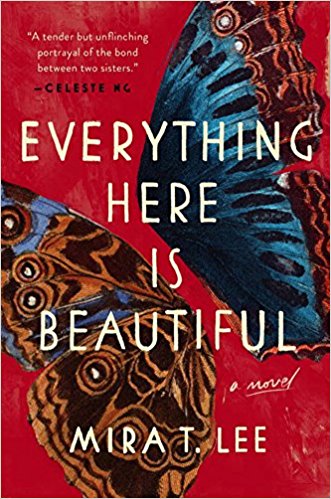
(3-26-18) Ever since Bebe Moore Campbell’s death in 2006, the mental health community has been desperately in need of a skilled novelist who can write a captivating story that offers readers a realistic portrait of mental illness while educating and entertaining them.
Such a novelist and a book are needed because novels reach a wide swath of Americans who would not be the slightest bit interested mental illnesses. Great novels can be timeless and speak to multiple generations.
The search has ended.
Mira T. Lee and her debut novel, Everything Here Is Beautiful, hits all the right marks.
First a word about Bebe Moore Campbell. Her first children’s book, Sometimes My Mommy Gets Angry, established her as a creative and credible writer about mental illness. It won the National Alliance on Mental Illness (NAMI) Outstanding Literature Award for 2003. As the title suggests, her children’s book is about a little girl who has to cope with her mentally ill mother.
 A key reason why Ms. Campbell could write so authentically was because she had mental illness in her family, a topic she further explored in her fictional 72 Hour Hold. She was well-known and well-respected in the NAMI community, having helped found the NAMI-Inglewood chapter.
A key reason why Ms. Campbell could write so authentically was because she had mental illness in her family, a topic she further explored in her fictional 72 Hour Hold. She was well-known and well-respected in the NAMI community, having helped found the NAMI-Inglewood chapter.
I greatly admired Ms. Campbell’s writing, courage, frankness and willingness to help others – including me. Before brain cancer ended her life, she wrote a complimentary blurb for the cover of my book CRAZY: A Father’s Search Through America’s Mental Health Madness.
To me, her’s were big shoes to fill. It isn’t easy to write about mental illness in fiction, especially if a seriously mentally ill character and the overall narrative does not fit nicely with the stereotypical, happy, redemptive ending that publishers and readers often prefer.
If writing about mental illness realistically isn’t enough of a challenge, try writing a book that doesn’t feature white, middle-class Americans as its main characters, but focuses on minorities and deals with such issues as immigration and how different cultures view mental disorders. Now consider that you have never before published a novel.
Mira T. Lee, who lives in Cambridge, Massachusetts, not only takes on all of these challenges, but conquers each with aplomb in Everything Here Is Beautiful. (Yes, I am repeating the title, because I don’t want you to forget it.)
The book tells the story of two sisters, Miranda, the eldest, who is straitlaced and serious, always responsible because she never has had another choice, and Lucia, the younger, headstrong and impulsive one, prone to living life on a grand scale. Their bond as sisters is tested when Lucia becomes mentally ill. Lucia, Miranda and the others in their lives must figure out how to deal with Lucia’s odd behavior.
Only someone who has dealt with a loved one with mental illness can write a passage such as this, spoken by Lucia:
“They said I ‘suffer’ from schizoaffective disorder. That’s like the sampler plate of diagnoses, Best of Everything.”
The sisters are Chinese-Americans, which adds an important depth to the story, but is risky for writers and publishers. In an interview done by her publisher to augment the book, Lee admits that she thought about casting her characters as white to make them more identifiable to a majority of American readers.
Cross-cultural stories in America still seem rare in fiction, but it’s true, mental illnesses do not discriminate. I decided to keep my characters the way they were, and now I’m really glad I did. I think it’s important to see these illnesses portrayed in communities of color, where stigma can be especially strong.
Everything Here Is Beautiful is markedly different from most novels too because Lee changes what is known as the POV (point of view) of the book’s narrator. The main story teller in the opening chapters is Lucia’s sister, Miranda, who suddenly has to deal with her younger sister’s illness. Later, readers are suddenly in Lucia’s mind and later in the minds of others witnessing an identical incident but seeing it much differently. Such writing is tricky to pull off – and the fact that her editor didn’t require her to stick with a single voice is gutsy.
Lee succeeds and the switching POV pays off. The switching viewpoints give readers a much broader view than a single voice. Bravo to Ms. Lee and her editors at Pamela Dorman Books/Viking!
Which brings me to another writing feat that has alluded many established authors, but which Lee again handles brilliantly. I’ll let her explain it:
“Mental illness, and particularly, schizophrenia, is a subject matter very close to my heart. I’ve seen my own family members struggle with it, and it is, in a word, devastating. But I didn’t want to write a book about an illness, I wanted to write a story about lives – specifically, four very different lives, and how each one’s trajectory was impacted by Lucia’s (mental illness.) These illnesses are unpredictable and pervasive, they screw up marriages, derail careers, jeopardize lifelong relationship with family and friends. Crisis happen just as a parent gets, sick, or a baby is born, or as Immigration shows up to deport an undocumented family member. And our mental health care system is riddled with intractable problems…I like a story with lots of nuance and, the ripple effects of mental illness certainly provide that…”
Wow, those of us who love someone with a mental disorder or live with mental illnesses know exactly what Lee means. More:
At points, I do try to educate the readers about some of the issues involved with psychotic illnesses – anosognosia (“lack of insight”), for example, or medications, or how the mental health care system works (or doesn’t) – because the readers needs an understanding of these issues in order to relate to Miranda’s frustration (with her sister). To me, great fiction happens when we find the humanity in each of our characters, no matter who they are or what their situations may be. Even when we’re unfamiliar with a particular experience, we can relate at an emotional level. I think that’s what empathy is all about.”
I don’t wish to give away too much of the plot, but those who are regular readers of this blog or are involved in NAMI will see where Ms. Lee drew part of her inspiration – a fact that she readily acknowledges.
After I gave a speech in 2009, Joan Bishop approached me with a local news clipping about her sister, Linda, who took refuge in an abandoned farm house after being released from the New Hampshire State Hospital with no follow up care. Linda kept a journal of her isolated, paranoid, and delusional final days, surviving on apples that she picked off the ground outside the farmhouse while waiting for an imaginary savior to rescue her. I published two blogs exposing the tragedy in February 2010. (see Linda’s Story Part One and Part Two.) The New Yorker published an article, ” GOD KNOWS WHERE I AM,” by Rachel Aviv two years later. Next came a powerful film by Todd and Jedd Wider with the same title as Aviv’s story. The film was played at last year’s NAMI national convention.
Lee credits Aviv’s article in her acknowledgements, and thanks Dr. Xavier Amador, whose book, I am Not Sick, I Don’t Need Help, was paraphrased in Lee’s book. She also thanks the NAMI Cambridge/Middlesex group for moral support. (I’ve been there twice and it is a fabulous NAMI group!)
Mira T. Lee’s book is a heartfelt story about sisters, family bonds, immigration, love, and an unvarnished look at how mental illnesses impact the lives of the person living with them and those who love and try to understand. How do you separate the illness from the person?
In Mira T. Lee, mental health has found a new novelist champion.




